Window treatments are sometimes an afterthought, relegated to their most basic function.
But the right window treatments can do more than protect the inside of your home from the sun’s rays. They can beautify your space, add value to your home, and save you money for years to come.
With so many options available, you might wonder where to start. Should you go straight to the store and start looking at options? Measure windows? Or call a company?
It's easy to make a decision about which window treatment to choose when you have the right information, and we've gathered everything you need to know in this guide. By the end, you'll know what you need to install shades, shutters, or blinds in your home.
Hive specializes in home automation, including smart window treatments, but we may not be the best fit for everyone's needs. We're providing this guide for anyone interested in the topic so you can feel comfortable adding window treatments in whatever way is best for you.
Window treatments refer to window coverings that help shield the interior of your home and can include shades, blinds, shutters, drapes, curtains, and more. But for the sake of this article, we’ll focus on three of the most common ones: shades, blinds, and shutters.

Shades are single panels of fabric that can move up and down to cover a window. Out of the window treatments we'll be covering today, shades are among the most versatile – they have a variety of colors, fabrics, and weaves to choose from, no matter your budget.
Many customers prefer them for their sleek, modern lines and ability to fit in with any room seamlessly. They can also allow both privacy and light exposure.
Shades can be motorized and controlled through smart apps or remotes. Higher-end shades can hide their motors entirely in the shade's tube, but more affordable options often have visible motors. You can also manually operate them with a cord, wand, or cordless lift.
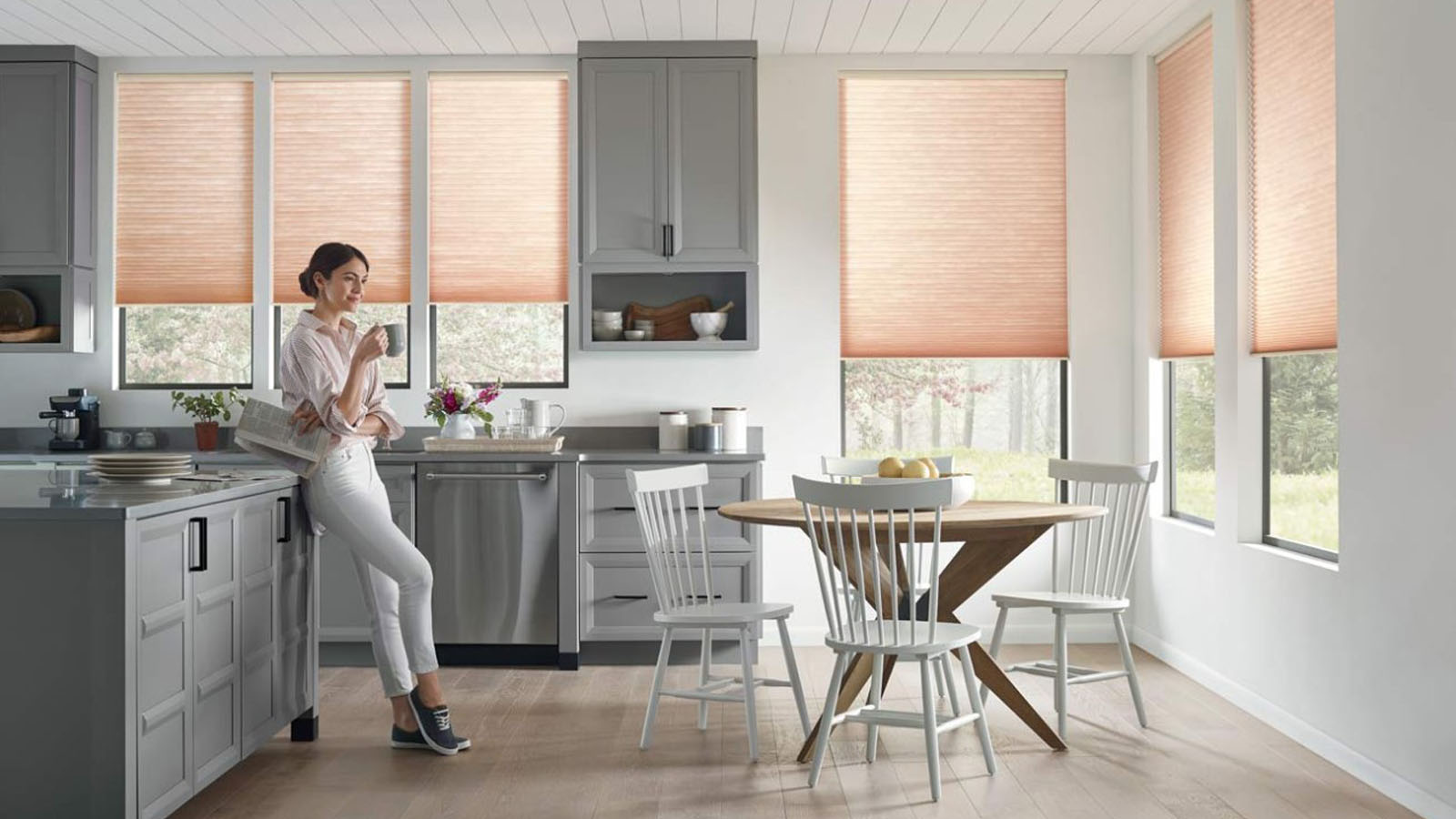
Blinds are a popular option for window treatments, as they offer light control and privacy while remaining affordable. They’re hard window coverings that can be drawn up or sideways using a wand, loop, or cables. You can adjust the amount of light that comes in and the amount of privacy you have by turning the louvers – also called slats.
Blinds have a classic look, and with the range of materials that they’re available in, they can fit any aesthetic you’d like.
Like shades, they can be motorized or manually controlled with a wand, cord, or cordless option.

Shutters are a hard, permanently fixed window treatment fitted in or around a window's casing. They let light in like blinds and shades, but many aren't as easily moved as blinds or shades. The louvers can often be moved, but they can't be pulled completely up or to the side.
This may seem like it doesn't have an upside, but it's a great option for those who might live close to their neighbors and don't want to fuss constantly with their blinds or shades. They're also very durable, so they're perfect for the inside and outside of your home, depending on the material you use.
Just because your windows aren’t in a standard shape or in a spot that’s easily accessed doesn’t mean that you’ll have to go without window treatments. There are also specialty window treatments that can go on unusually shaped or placed windows, like circular or arched windows or skylights.
There are also a variety of different styles such as roman shades, silhouettes with veins that open and endless custom fabric configurations for a more luxurious finish.
Installing window treatments can benefit your home and life in several ways.
While technology like smart thermostats can keep your energy bills down, window treatments can help too. Thoughtfully-placed window treatments can reduce heat gain by 77%, reducing the burden on your heating and cooling systems and by extension, your wallet.
With smart technology that moves your window treatments based on the time of day or exposure to the sun, you can save even more money. And, as we’ll get into when we discuss choosing materials for your window treatments, certain fabrics, colors, and features can maximize your energy savings.
Without window treatments, anyone passing by can see into your home. Some shades, blinds, or shutters provide more privacy than others, depending on the material and mechanism used to move them.
Window treatments can also be a great security tool. Keeping them down during the day can prevent potential burglars from seeing your valuables. If your window treatments are connected to a smart home hub, you can set them to open or close to give the impression that you're home, even if you aren't.
Making your window treatments smart or motorized is a great way to make your life a little easier. You can open or close them with a few touches of a button or schedule them to open at particular times.
Instead of interrupting your work to partially close your blinds, you can use voice commands to do that for you or press a few buttons on an app or remote control. You can also schedule them to open when the sun rises to wake you up gently. Combining that with blackout shades and timing them according to your circadian rhythm can improve your sleep.
Shades, shutters, and drapes are a great way to improve the look and feel of your home. The options available are endless and can fit any home decor style.
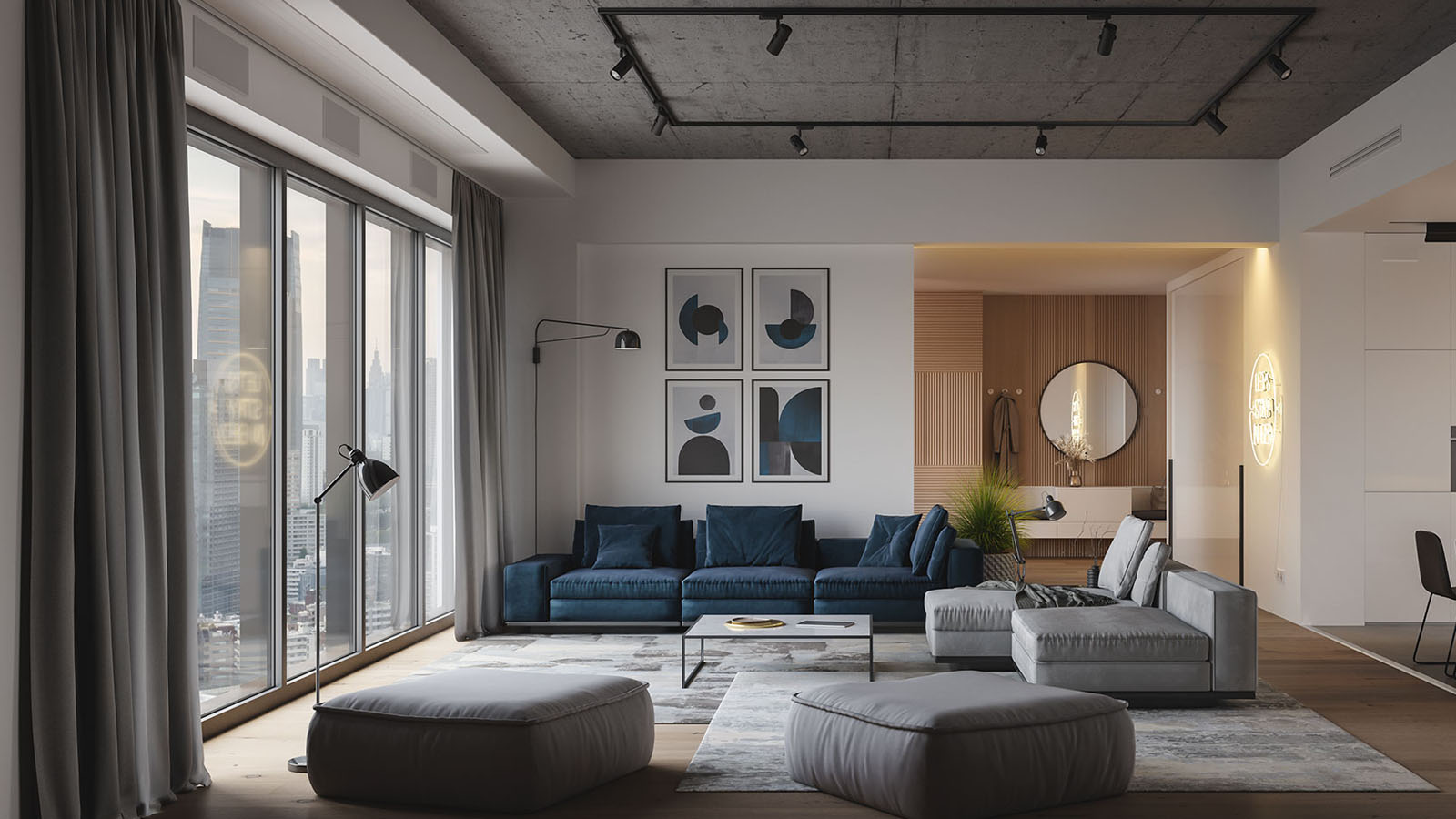
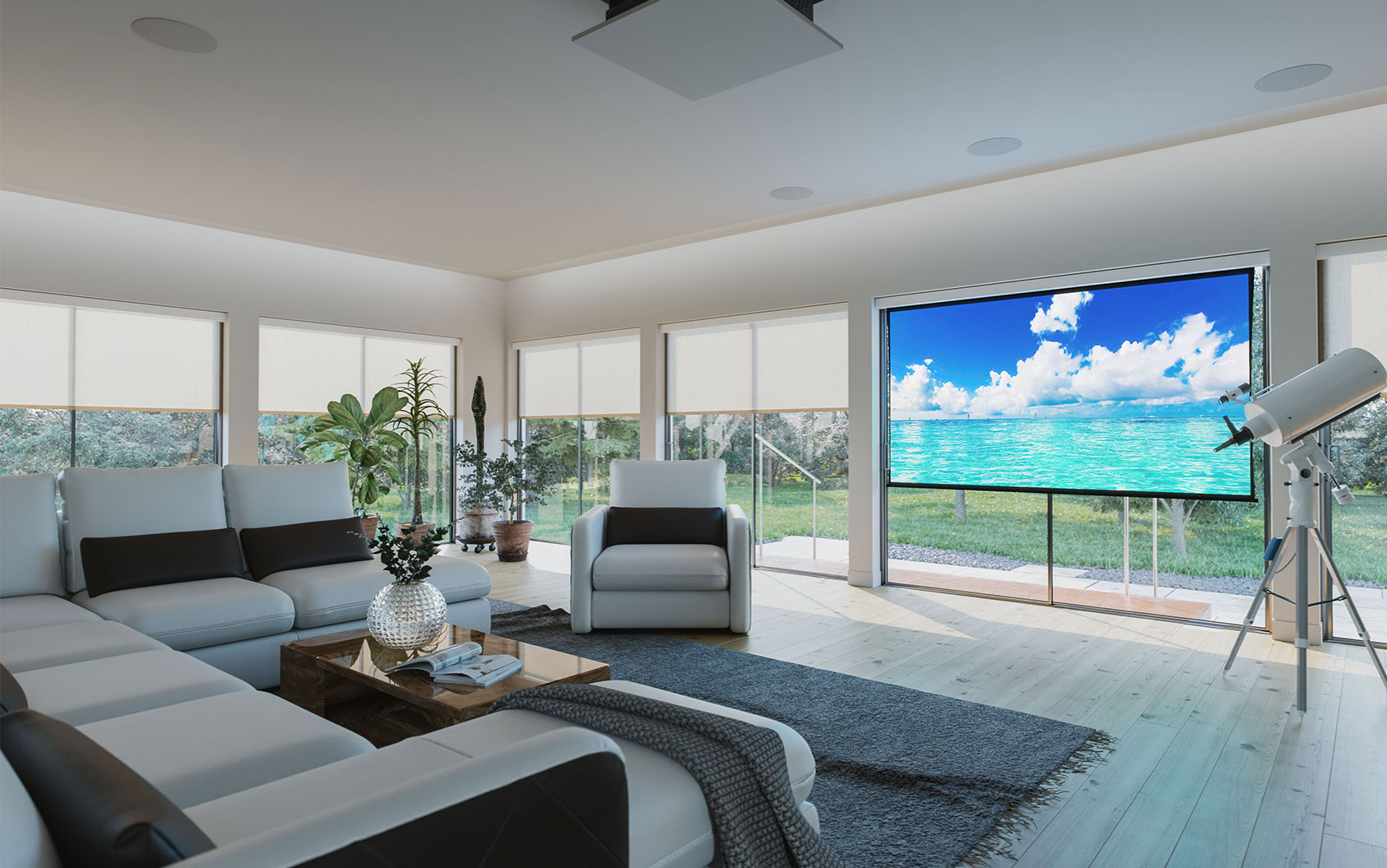
Having professionally installed window treatments can be a selling point for potential buyers. First, it saves them the time and money required to put them in themselves, and second, you can improve the visual appeal of your home. You can expect to add 30% of the amount you paid for the window treatments in value to your home. If you're in a storm-prone area, certain kinds of window treatments, like hurricane shutters, can add even more value to your home. The value of your window treatments increases even more when you integrate them into a smart home hub. Potential buyers value convenience, especially when they don't have to go out of their way to install it.
Cordless or motorized window treatments are an excellent option for families with young children or pets who may accidentally get strangled or injured by the cords dangling from certain window treatments. Sadly, there are around 200 incidents per year involving children under eight and window treatment cords, leading to serious injury or sometimes death. Thankfully, the Window Covering Manufacturer’s Association updated the standard for all window coverings sold in retail and online stores in 2018 to be cordless or have short, inaccessible cords. However, custom or made-to-order window treatments can have longer cords for those who can't reach them due to physical limitations if those are a better option for you and your family.
We've discussed three kinds of window treatments here – blinds, shades, and shutters – and each has strengths and weaknesses. There are also a lot of options within each category, but we'll focus on the broader categories here.
We’ll judge each of these options on the following criteria:
Blinds give you the most control over the amount of light you let in and the amount of privacy you have. With a simple turn of a wand, pull of a cord, or press of a button, you can turn your blinds’ louvers to let light filter in, pull the blinds up entirely to give yourself a full view or close them for privacy.
While the individual louvers help you control them to whatever specifications you’d like, they also collect dust rather quickly and can be difficult to clean. It’s possible with a duster and a diligent cleaning schedule but if your blinds are in a place that’s hard to reach, they might not be the best option.
However, if they're in a place that pets or kids easily reach, they can be bent and damaged if you aren’t careful.
Blinds also allow a lot of visibility if the louvers are open and drawn up or to the side. However, because blinds "stack", you'll lose about 15 to 50% of your view if you pull them up or aside entirely.
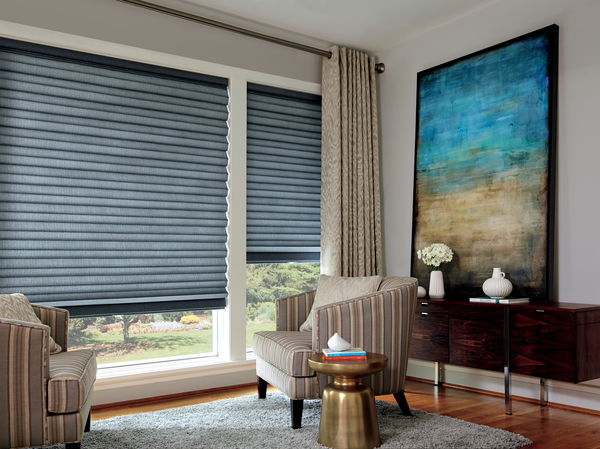
Since blinds are so easily moved, they can be a good option for privacy – all you have to do is close them. You can also have the louvers partially open to let sunlight in while preventing people outside from seeing straight in.
They aren’t the best option for privacy since at some point, you’ll have them open, but for most, they provide more than enough coverage.
Pros:
Cons:
Shades are as easily controlled as blinds are, often with a chain or a motor to raise and lower them. However, the amount of privacy and light you have control over isn’t as flexible as it is with blinds. Essentially, once you choose the fabric and the openness of the weave, you’ll have a “set” amount of privacy with the shades down.
For example, if you want a lot of light, you might choose shades with a more open weave that doesn’t allow for as much privacy as one with a tighter weave. You can’t change the weave once you’ve selected it, so you’ll only be able to move your shades to
However, top-down, bottom-up shades can be moved to be in the center of the window, allowing you the ability to see outside, but conceal the furniture inside your home.

Shades don’t collect dust the way blinds and shutters do, a huge plus for many. Many are also covered in a thin resin-like layer that repels most dust and dirt.
However, traditional shades can also be in reach of children and pets. A child’s sticky fingers could mean a spot that’s difficult to spot-clean, or your cat’s urge to scratch could mean that the bottom of your shades are torn to shreds.
If they do get dirty, they’re not easily taken down, though they can be spot cleaned. Overall, these problems don’t make shades an unattractive option; it’s just a matter of choosing a fabric that’s compatible with your needs, which we’ll get into shortly.
Shades allow for full visibility when they’re up, as they roll up above the window rather than stacking like blinds do. The amount of visibility your shades allow while they’re down depends on a few factors – namely, the fabric’s openness and color.
Openness, which is also sometimes called opacity, refers to how much light is let through the shade. The lower the percentage, the less light enters a room. For instance, a shade with 3% openness lets in less light than a shade with 10% openness. 3-5% openness is ideal for a balance between privacy and adequate light, while 1% openness is a perfect fit for when you want full privacy while letting some light in.
The color of your shade also factors into how much you can see through them. Counterintuitively, it’s easier to see through darker shades with a good openness level rather than lighter-colored ones. If you have dark shades with a higher openness level, you’ll be able to see out of your shades more.
The amount of privacy that shades provide goes hand in hand with the amount of visibility they allow. Shades that are easier to see through and that let more light in give you less privacy. You can have shades with a low openness level and a lighter color that prevent people from seeing inside.
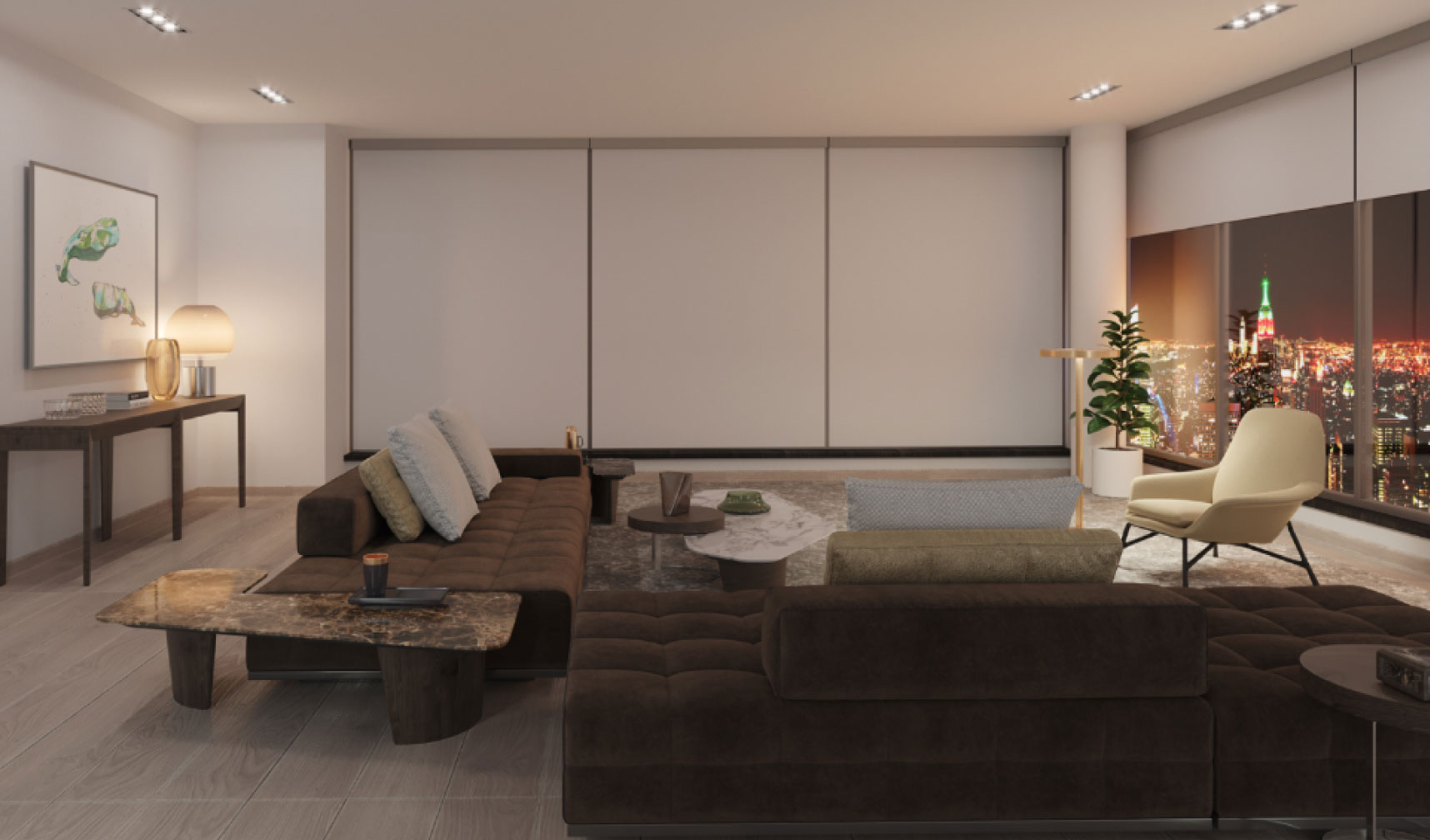
However, it’s important to note that people outside will still be able to see shadows of whoever’s inside at night.
Pros:
Cons:
Shutters aren’t necessarily static; with some types, you can move the louvers and even have them controlled with a remote, or you can open them, but in some instances, they can’t be moved easily.
And because of this, they might not be the best option for a space where you’d like a view or you’d like the option to open or close them more regularly.
Shutters have a similar problem to blinds in that their hard surface attracts dust and cleaning each louver can be time-consuming. This problem is especially prevalent in exterior shutters, which are exposed to weather and temperature fluctuations.
However, because they’re often placed outside, they’re made of materials that can withstand their environments and can be cleaned relatively easily.
The biggest weakness of shutters is their visibility; in many cases, they’ll always be in view as you can’t roll them up or push them to the side. In some instances, they’ll be pulled out of the way, but in others, they’ll always be in front of the window.

Shutters are an excellent choice for privacy for the reasons why they’re not the best for visibility. They can let light in while providing coverage.
For instance, if your home is very close to your neighbors on either side, shutters can keep some light coming in while making sure your neighbors can’t see inside.
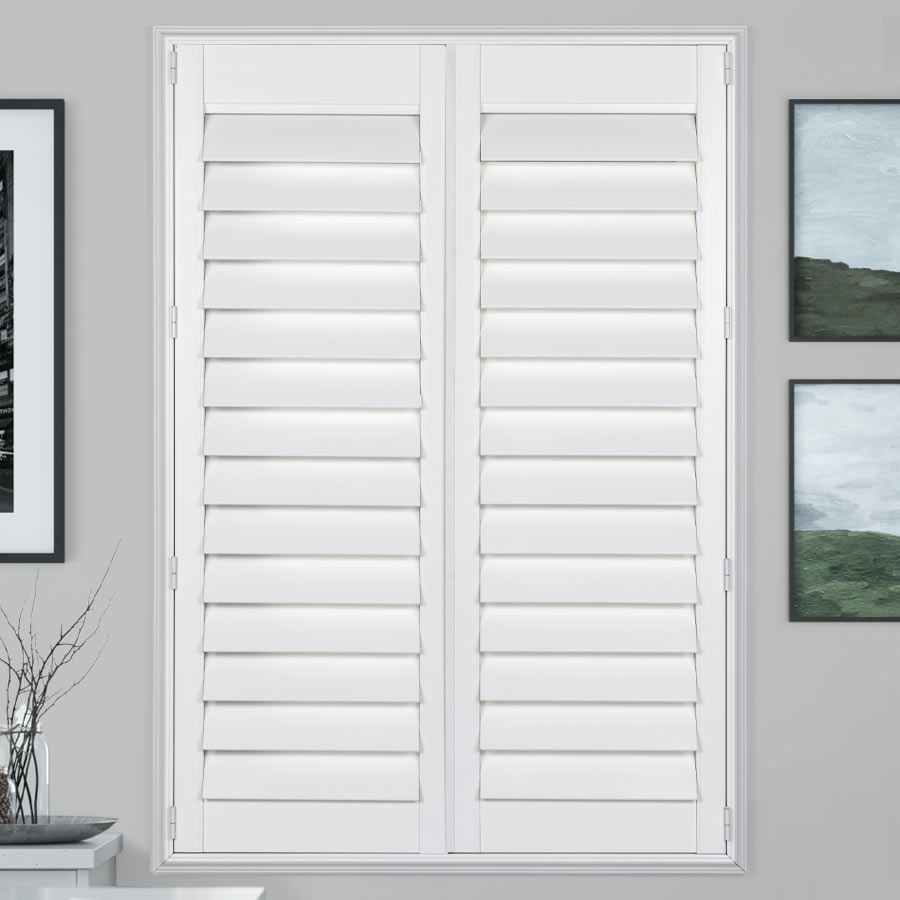
There are many factors to consider when choosing your window treatments, but going through them doesn't need to be an overwhelming experience. The factors to consider when choosing your window treatments are:
You can download our guide here if you'd like a step-by-step guide on choosing your window treatments.
Shades can be motorized or manual, and each kind has its benefits. First, let’s talk about motorized shades since deciding on them requires a few more decisions.
Motorized window treatments are run by motors that open and close, or raise and lift them. And motorized shades can be split into two subcategories – hardwired and battery-powered.
Hardwired motorized window treatments are connected directly through your home's power source. These can be low-voltage for lightweight window treatments, or high-voltage for heavier fixtures that need more power to drive the motors.
Most window treatment manufacturers are low voltage, which is a more affordable option because you don’t need an electrician to install them.
The motor can sometimes be hidden within the fixture, like in the case below, but sometimes the motor will be visible.
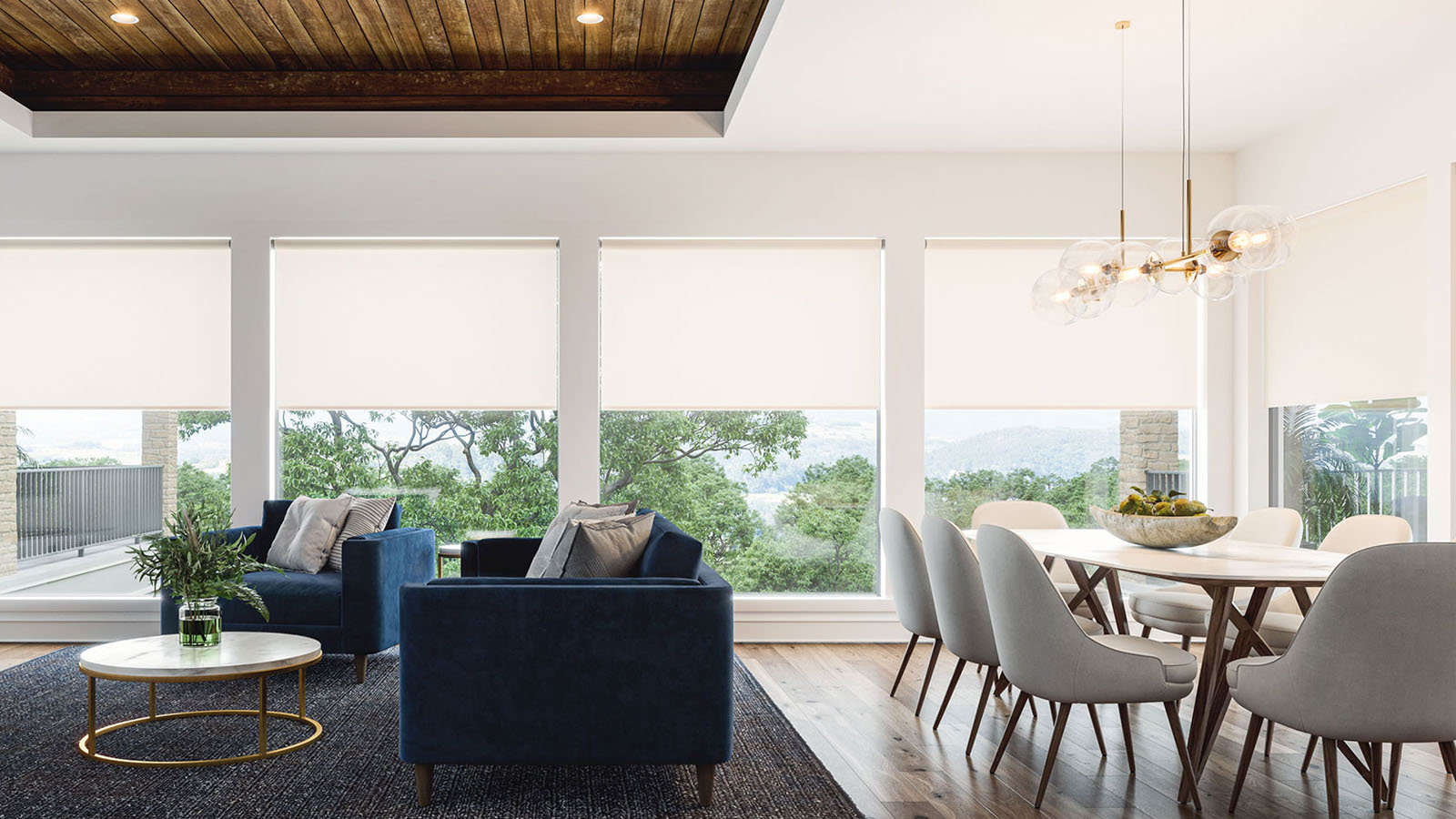
Hardwiring also means that their connection to your home automation system is much more stable, as it doesn’t rely on wifi or batteries.
Battery-powered window treatments are self-explanatory – they’re powered by batteries. Typically these batteries are rechargeable, though manufacturers have had options that used standard batteries in the past. They can last up to a year and a half to two years on a single charge.
Battery-powered window treatments are typically a better option for homes that don’t have the preexisting wiring for hardwired window treatments.
You’re likely familiar with manual window treatments; they’re the most common way to control them. Manual window treatments are usually controlled with a cord, wand, or push system.
As we mentioned above, cords can be a risk to children and pets. However, wands and other cordless systems are just as common and aren’t as much of a danger.
The options for materials can feel endless, but we can break them into two main categories – hard and soft materials.
Common hard materials for blinds and shutters include:
Soft materials for shades can be nearly any material you’d like, and brands have options for nearly every aesthetic and budget. You can pick a fabric that’s more suited to your lifestyle, like a sturdier fabric that’s easier to spot clean, though many fabrics are coated in a poly-resin that makes them even easier to clean. There are literally thousands of possible options and combinations.
The color of your window treatments also factors in. Lighter colors reflect more light, brightening a room, while darker colors absorb it. As we mentioned above, it’s easier to see through dark, open fabric if your view is something you’d like to maintain.
Window treatments can be installed in many cost-effective ways, which we’ll get into later in this article. In short, understanding what you want and need will allow you to choose window treatments that are a great fit for both your life and your wallet.
Like lighting, audio, and security, motorized window treatments can be automated to work with your smart home hub. And also like other forms of home automation, you can either have a system that works seamlessly through one hub, or a system that requires four different remotes or apps and feels more complicated than just pulling the cord to open them.
Smart window treatments can be connected to all of the major smart home systems, from Amazon’s Alexa to Google Home to Josh AI. It all depends on the type of window treatments you buy.
However, if you want your systems to work together, it’s advisable to talk to a home automation professional. They’ll know what brands to suggest so you can easily operate your shades from one hub.
But you can start making your decision by determining how you’d like to control your blinds – with your voice or with app and remote controls.
Voice control options are popular for a reason – they’re easy to use and effortless once they’re programmed. Popular options include:
Remote control and apps are also a convenient choice, and there are more options than ever. Some popular ones include:
Again, talking to a home automation expert can ensure that your window treatments sync up with your smart home automation hub of choice and any other home automation you currently have.
Installing window treatments like shades, shutters, or blinds is more complex than putting up curtains. But at first glance, it’s not particularly difficult – you measure and with a few tools, you put them up.
But installing window treatments has more pitfalls than many people expect. You can measure them incorrectly, leaving you with window treatments you can’t return, or you can place them in a way that doesn’t allow them to fully go up and down. If you’re automating them, you might end up with something that doesn’t work with all of your other home automation.
With that in mind, let’s talk about when doing it yourself is appropriate and when it’s best left to the professionals.
Doing it yourself is always a less expensive option than hiring a professional to do the work for you – the only labor cost is your own time. You can also purchase and install them on your own time instead of scheduling an appointment with a professional and rearranging your schedule.
Also, if you’re a handy person and understand the nuances of measuring for something like a window treatment, you may feel more confident in taking on the project yourself.
DIY window treatments make sense if you:
If you’ve ever started a home improvement project yourself and ended up standing in Home Depot, frustrated and confused, you might want to hire a professional. Having a professional measure, order, and install your window treatments is definitely an added cost, but it can save you from incorrectly measured window treatments that you can’t get a refund on.
Additionally, a professional will be able to measure and install in areas that aren’t as easily accessed, like windows on a second floor or windows in a corner.
Hiring a professional installer makes sense if you:
Though each company varies in the specifics of its installation process, you can expect the following things to happen in a professional window treatment installation after deciding on what kind of treatment you'd like:
First, a professional will come out to measure for your desired window treatment. They’ll ensure that your measurements are correct for what you’d like and where you’d like to put them.
Typically, this is where you’ll get a quote, as most installers charge by certain measurements. Like we said before, the more material necessary, the more you’ll need to pay.
Once the pros have measured for your window treatment, they’ll need to be ordered. Customers are often surprised that this sometimes takes up to two months, so keep that in mind if you’re getting custom window treatments.
Your installation team will put up the necessary hardware to install your window treatments, which will include drilling and the associated clean-up. If your window treatments are hardwired, they’ll install any necessary wires, connect them to your power system and program them to your smart home hub.
If they’re powered by rechargeable batteries, they’ll program them using whatever app integrates with the shades.
Ultimately, you know yourself and what you’re capable of, both in terms of installation and budget.
If you’d like to do it yourself, figuring out what kind of window treatments you’d like and researching installation on Youtube are great first steps. A big box store like Home Depot or Lowes is a great place to start your search.
If you’d like to hire a professional, you should also start by determining your needs and what you’d like from your window treatments. From there, research local companies that can help you complete your project through a site like Houzz or Thumbtack.
As with anything in your home, window treatments can have problems. Thankfully, most of them can be avoided with careful planning and decision-making.
As we’ve discussed throughout, window treatments can be tricky to install depending on your home. You can place a treatment that’s too heavy in a wall that can’t support it. You can also place them too high or too low, which may let in more or less light than you wanted. Some spaces might not be suitable for certain window treatments, leading to trouble down the line.
However, you can avoid this by understanding your space or hiring a professional.
Some types of window treatments are more difficult to clean than others, as we detailed above. If you have window treatments in places that are hard to reach or if you have children or pets, you may want to consider a material that’s easier to clean and maintain.
Most people have experienced the frustration of one side of their blinds going up while the other stays down. Window treatments can sometimes break if improperly used or installed.
Avoiding this problem is a matter of choosing high-quality shades; the higher quality of the shades, the more likely they are to stand up against misuse. Many quality brands also have five-year or even lifetime warranties in case something breaks.
Because shades are constantly exposed to light, and in some cases the elements, they can warp, fade, yellow, or lose their shape. Choosing the right material for the environment and buying high-quality shades that won’t degrade with sun or humidity will allow you to keep your window treatments for years to come.
The price range of window treatments is wide, which can make choosing your budget daunting. Let’s break down all of the factors that can affect cost when choosing your window treatments.
While there are window treatments at every price point depending on other factors like its material and the size of the window, some fixtures typically cost more than others. On average, blinds are the most affordable option, followed by shades, with shutters as the highest-priced of the three.
But again, these are rough estimates. If you feel that shutters are the best fit for your needs, you can manage the other cost aspects we’ll go into below to find a price that’s right for you. Or if you would like blinds and want a luxury product, you can also choose materials or options that are higher-end.
Some window treatment materials like real wood cost much more than others, like resin or vinyl. While it’s important to match the material to your lifestyle needs, it’s also important to choose one that’s a good price for you.
Luckily, brands offer more options than ever, so you can find a material that’s the right price, color, and durability for your needs.
Choosing between motorized and manual shades can be a huge factor in the price of your window treatments.
Choosing a motorized shade option can double the price of your window treatment. If you decide on hardwiring your motorized shades and you don’t have your home prewired, you’ll also have to pay for the installation costs.
The size of the window’s effect on the cost is straightforward – the bigger the window, the more material you need.
Doing your shades yourself is a less expensive option, but doing so when you’re inexperienced can get you window treatments that aren’t installed correctly.
Choosing a professional can ensure that you get shades installed properly, though it’ll be more expensive. For many, that cost is worthwhile.
While we don’t know your financial situation, we can tell you that reviewing the factors to consider when choosing window treatments is a great place to start. Once you have all of your needs aligned with what window treatments are best for your home, you can decide on how much you’ll likely need to spend.
We hope this guide has given you the knowledge to feel comfortable choosing window treatments for your home. But if you’re unsure where to start, think about the specific reasons why you’re getting window treatments.
Some reasons for getting window treatments align with the benefits we listed above:
From there, you can decide whether you’d like to do it yourself or hire a professional. If you’d like to take on the project, you should start by determining your budget and type of fixtures you’d like before heading out to purchase your window treatments.
Hiring a professional might be your preferred route. In that case, start with your budget before researching well-regarded installers on sites like Angi or Thumbtack.
Do you want a step-by-step guide to what you need to pick your window treatments? You can download our Guide to Choosing Window Treatments worksheet here.
If you’d like to know more about how Hive can help you with your window treatments, you can check out our service page or contact us here to set up a free consultation. We’re also available for any other smart home needs you may have.


